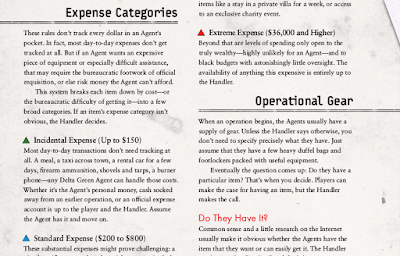Natasha Avram, former Russian government assassin. Wears a lot of leather. Driven by money. Possible sociopath.
Sten Brodrington, ace driver who is a bit vague about which specific branch of British intelligence he worked for. He's looking for direction and purpose in life, or at least that's what he says.
Max Fischer, German investigator with a mysterious past. A little twitchy. He's hoping for some sort of redemption.
Carmel Shaked, Israeli break-and-enter specialist with a bit of a nationalistic streak. Carmel has had enough of secrets and lies.
The team attempts to sneak across the border but is stopped for speeding by the Romanian police. Max offers the officer a €200 incentive, which is accepted, and the team is allowed to carry on.
Once over the border into Bulgaria, they head for the nearest hospital to get Sten patched up; while Sten is checked in, Max and Natasha wander downstairs to the hospital's waste incinerator and hand over another incentive to get a few minutes alone with the device. They burn Natasa Dobra's severed head and collect the ashes; Natasha then scatters the ashes in a nearby stream. Meanwhile Carmel finds a junkyard and makes off with a set of number plates in order to disguise the team's car.
While Sten recovers in hospital, the rest of the team rests in a rented cottage just outside of town. Days pass, during which each member of the team takes steps to change their appearance; although they have dropped off Interpol's wanted list thanks to intervention from EDOM, their pictures are being circulated in Romanian law enforcement circles.
The 25th of August rolls around and Sten discharges himself from hospital and joins his colleagues. He decides to test the serum recovered from EDOM's base on himself, and discovers that the liquid bestows certain special abilities, although nothing like those displayed by Carmel during the fight with Dobra.
The team decides to try to find Dracula using the same ritual it used to pinpoint Dobra's location, and spends the next few days preparing. It is believed that the spell can only locate objects, not people, and although there is some discussion over whether Dracula counts as a person given that he's been dead for 537 years, the team decided to focus the ritual on... the shirt he was wearing in Gibraltar.
On the 1st of September, they enact the ritual and locate the shirt in the InterContinental hotel in central Bucharest. Before they can narrow the location of the garment down any further, Natasha's perimeter alarm is tripped.
There is nothing on the cameras, but as vampires would not appear on camera, that does little to comfort the team. Natasha sticks a shirt on a stick and waves it past a window, attracting a burst of gunfire; noting the location of the shooter, the Russian lobs a grenade at the spot, while Carmel teleports to the cottage's shed. The anguished scream following the grenade's explosion suggests that it found its mark.
 In return, a missile takes out one corner of the cottage, exposing the team to attack, and a pitched gun battle ensues. Natasha is cut down as she sprints from the cottage to the shed, Max and Sten chuck grenades everywhere, and Carmel teleports into the cover of the trees and begins stalking the team's attackers.
In return, a missile takes out one corner of the cottage, exposing the team to attack, and a pitched gun battle ensues. Natasha is cut down as she sprints from the cottage to the shed, Max and Sten chuck grenades everywhere, and Carmel teleports into the cover of the trees and begins stalking the team's attackers.Natasha crawls into the shed and performs hasty field surgery on herself to stem her blood loss, while Carmel incapacitates one would-be assassin with a stun gun; a second attacks her with his own shock weapon, and the two get into a brawl which continues without a clear victor -- despite the former Mossad agent's newfound supernatural edge -- until Carmel's first opponent shakes off the stun effect and enters the fray.
Outnumbered, Carmel drops a grenade at her feet and runs off into the trees; one of her opponents pursues but the other is slower to react and is blasted to bits by the explosion. Natasha pulls herself into a sitting position and although woozy from blood loss and pain, is lucid enough to pick off Carmel's pursuer with a precise rifle shot to the head.
No further shots are fired and silence falls. The team sends up its drone and the machine's infrared camera picks up five humanoid shapes moving away from the scene.
They waste no time, and recover what gear they can and pile it in their car, only to discover that the vehicle has been sabotaged and won't start. Natasha is too fragile for an escape on foot so the team takes a risk and calls for a taxi; while she waits, Carmel checks the bodies for identification and finds nothing of use, although a few of them have Romanian military tattoos. Max loots a suit of combat armour from the assassin that Natasha decapitated.
The cab arrives and the team clambers in before the driver can get a good look at the devastation; he drops them off back in town, where a car is rented and the team drives off into the countryside, taking random turns in order to shake off any potential pursuit.
No vehicles follow but Max spots a
Sten spots a man standing in the road ahead and accelerates further; to his mind, the man is either an enemy or an idiot and deserves what he's going to get. The car hits the man going at about 120 miles an hour; or rather it would, but the man steps aside at the last second, grabs the vehicle, and flips it into the air.
(At this point, everyone checks their character sheets to make sure they are not playing Champions by accident.)
Sten does his best to lessen the damage, but British Intelligence Driving School didn't cover being thrown through the air by a vampire. The car rolls a few times before coming to a rest upside down; airbags and seatbelts prevent the worst of the damage, but Natasha's wounds reopen and she is bleeding out.
The man strides up to the car and tears the doors off, then drags the team members out of the vehicle, one by one; they are too dazed to put up much resistance. He lays them at the side of the road and fixes them with a red-eyed glare; it looks like he is struggling to control his anger.
"You have four days," he hisses, "Then I will come for you." Then he walks off into the night.
Next: boss fight!






